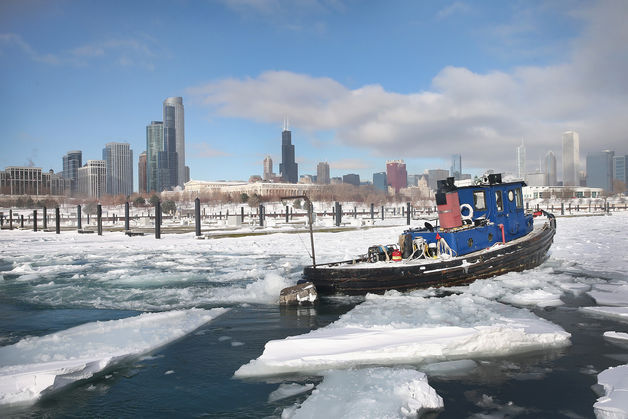
Temperatures across the eastern U.S. and parts of Ontario and Quebec will be at least 8 degrees below normal through Jan. 27, said Matt Rogers, president of the Commodity Weather Group LLC in Bethesda, Maryland. Next week will be colder, he said.
"The crazy thing is that the current cold snap this week looks to be a bit more modest in the face of next week's outbreak," Rogers said. "The cold coming for the end of January is sufficient to make this the coldest month of the century so far and the coldest the Lower 48 has felt in at least 20 years."
Temperatures in Chicago fell lower than the South Pole this month as freezing weather boosted energy consumption, grounded thousands of flights across the U.S. and disrupted operations at refineries and natural gas production sites.
The natural gas-weight heating degree days value for January is expected to reach 1,062.9, higher than the five-year average of 949.5 and the coldest since 2001, Rogers said.
The value is determined by subtracting the daily average temperature from a base of 65 degrees Fahrenheit, the resulting number is a measure of how cold it is and how much energy is needed to keep homes and warm.
Cold Front
"A wave of low pressure along the cold front currently settling into the southern states is expected to spread a rare coating of ice across southeast Texas and southwestern Louisiana," the National Weather Service said.
The service forecast snow, sleet, and rain over parts of Texas and the central Gulf Coast through tomorrow morning.
Natural gas futures headed for the biggest weekly gain since September 2012, rising as much as 3.9 percent to $4.913 per million British thermal units in electronic trading on the New York Mercantile Exchange today. They are up 13.6 percent this week.
Rogers said four of the 10 coldest days of the 21st century in the 48 contiguous U.S. states occurred this month, including the first and second.
Much of Texas is forecast to get eight to 10 hours of below-freezing temperatures through today, said Tom Kines, a meteorologist with AccuWeather Inc. in State College, Pennsylvania.
Wind chill warnings and advisories stretch from Canada to the U.S. Gulf Coast and a winter storm warning has been issued in Houston, according to the National Weather Service.
Snow Storm
Houston may get 0.25 inch of freezing rain and possibly some snow, according to the weather service.
"It takes very little of that stuff to cause major problems down there," Kines said.
Temperatures in the U.S. Northeast will remain in the low teens to even single digits through this weekend, according to the weather service. Readings may reach seasonal levels by Jan. 25 before dropping back down again.
Kines said there is also a chance a storm may bring 4 inches of snow throughout the region at the start of next week, though details of where it will land are still to be determined.
The pattern for the month has been one of deep cold snaps followed by brief respites, Kines said. The Great Lakes has borne the brunt of the trend, with many days of frigid readings.
Chicago has had nine days, and in Milwaukee, where readings have fallen to zero or below, there have been eight so far this month, according to the weather service.
To contact the reporter on this story: Brian K. Sullivan in Boston at bsullivan10@bloomberg.net
To contact the editor responsible for this story: Dan Stets at dstets@bloomberg.net



Reader Comments
to our Newsletter